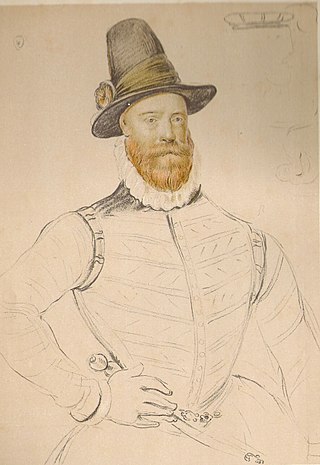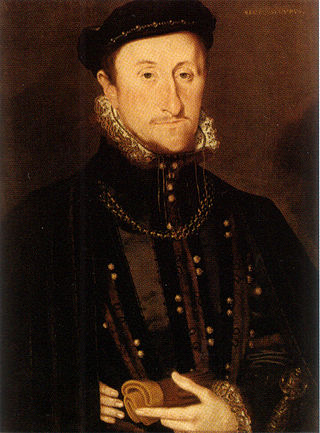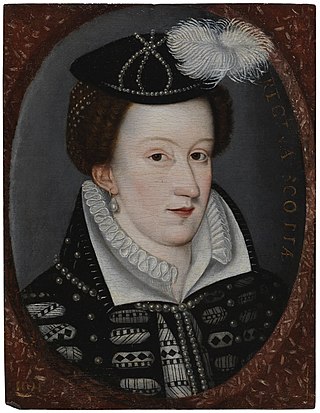Related Research Articles

James Douglas, 4th Earl of Morton was a Scottish nobleman. He played a leading role in the murders of Queen Mary's confidant, David Rizzio, and king Henry Darnley. He was one of the last of the four regents of Scotland during the minority of James VI and I. He was in some ways the most successful of the four, since he won the civil war that had been dragging on with the supporters of the exiled Mary, Queen of Scots. However, he came to an unfortunate end, executed by means of the Maiden, a predecessor of the guillotine.

James Stewart, 1st Earl of Moray was a member of the House of Stewart as the illegitimate son of King James V of Scotland. At times a supporter of his half-sister Mary, Queen of Scots, he was the regent of Scotland for his half-nephew, the infant King James VI, from 1567 until his assassination in 1570. He was the first head of government to be assassinated with a firearm.

John Erskine, 1st Earl of Mar was a Scottish aristocrat and politician. He was the custodian of the infant James VI of Scotland and Regent of Scotland.
George Gordon, 5th Earl of Huntly, was Lord Chancellor of Scotland and major conspirator of his time.

The murder of Henry Stuart, Lord Darnley, second husband of Mary, Queen of Scots, took place on 10 February 1567 in Edinburgh, Scotland. Darnley's lodgings were destroyed by gunpowder; his body and that of his servant were found nearby, apparently having been strangled rather than killed in the explosion. Suspicion was placed upon Queen Mary and the Earl of Bothwell, whom Mary went on to marry three months after Darnley's murder. Bothwell was indicted for treason and acquitted, but six of his servants and acquaintances were subsequently arrested, tried, and executed for the crime.
William Baillie, Lord Provand was a Scottish judge from Lamington.
Patrick Lindsay, 6th Lord Lindsay of the Byres, (1521–1589), Scottish courtier and Confederate lord.
Servais de Condé or Condez was a French servant at the court of Mary Queen of Scots, in charge of her wardrobe and the costume for masques performed at the Scottish royal court.
Annabell Murray, Countess of Mar (1536–1603), was a Scottish landowner, courtier and royal servant, the keeper of the infant James VI and his son Prince Henry at Stirling Castle
Margaret Beaton, Lady Reres was a Scottish courtier and companion of Mary of Guise and Mary, Queen of Scots. She was blamed by the enemies of Mary, Queen of Scots, for her involvement in alleged immorality at court.

Nicolas or Nicoll Elphinstone was a Scottish courtier and diplomatic messenger. He was the son of Lawrence Elphinstone of Selmys, 1435-1515. He worked for James Stewart, Regent Moray and was involved in attempts to sell the jewels and pearls of Mary, Queen of Scots in 1567 and 1568. Moray needed to raise money to govern Scotland and subdue Mary's supporters by force.
Timothy Cagnioli was an Italian merchant and banker in Scotland. Cagnioli was active in Edinburgh during the Regency of Mary of Guise and the personal reign of Mary, Queen of Scots. As a merchant he supplied luxury fabrics used in costume and interior decoration. He was able to lend large sums of money and issue letters of credit needed by travellers abroad.
Robert Anstruther was a Scottish soldier in the service of Mary of Guise and Mary, Queen of Scots.
Robert Abercromby or Abircrumby was a Scottish leatherworker serving the Scottish monarchy in the 16th century.
The baptism of James VI was celebrated at Stirling Castle in December 1566 with a masque, fireworks, and a staged assault on a mock fortress. The entertainment was devised by George Buchanan and Bastian Pagez.
Jerome Bowie was a servant of James VI of Scotland as a sommelier and Master of the Wine Cellar, in charge of the purchase and serving of wine.

Records survive of the expenses made to feed the Scottish royal household in the sixteenth century, and the remains of royal kitchens can be seen in the ruins of palaces and castles. Archaeologists can recover evidence of diet from deposits including waste from meals and food preparation.

Helen Littil was a Scottish courtier, the nurse of King James VI and I.
Andrew Hamilton of Goslington, Newton, and Silvertonhill was a Scottish landowner.
The Book of Articles is a list of allegations against Mary, Queen of Scots and James Hepburn, 4th Earl of Bothwell. The document was produced for the Westminster Conference in December 1568. The manuscript, held by the British Library, was written by Alexander Hay of Easter Kennett, and is sometimes known as Hay's Articles. The material resembles George Buchanan's published Detection and his Indictment of Mary. The text was published by John Hosack in 1869.
References
- ↑ John G. Harrison, 'The Royal Court and the Community of Stirling', Forth Naturalist and Historian, 30 (2007), p. 40.
- ↑ Gordon Donaldson, Thirds of Benefices (Edinburgh: SHS, 1949), p. 193.
- ↑ Andrea Thomas, Princelie Majestie, p. 241: James Balfour Paul, Accounts of the Treasurer, vol. 7 (Edinburgh, 1907), p. 131: The royal household accounts show that he was in Edinburgh Castle with Mary of Guise in 1560.
- ↑ John Hill Burton, Register of the Privy Council of Scotland, 1545-1569, vol. 1 (Edinburgh, 1877), pp. 497-8.
- ↑ Gordon Donaldson, Thirds of Benefices (Edinburgh: SHS, 1949), p. 190.
- ↑ Charles Rogers, Rental Book of the Cistercian Abbey of Cupar-Angus Abbey, vol. 2 (London, 1880), p. 281.
- ↑ John G. Harrison, 'The Royal Court and the Community of Stirling', Forth Naturalist and Historian, 30 (2007), p. 41.
- ↑ Joseph Bain, Calendar of State Papers Scotland, vol. 2 (Edinburgh, 1900), p. 667 no. 1117.
- ↑ Gordon Donaldson, Thirds of Benefices (Edinburgh: SHS, 1949), p. 193.
- ↑ Register of the Privy Seal of Scotland, vol. 5:2 (Edinburgh, 1957), p. 280 no. 3254.
- ↑ Calendar State Papers Scotland, vol. 2 (Edinburgh, 1900), p. 393 no. 617.
- ↑ Exchequer Rolls, vol. 20 (Edinburgh, 1899), pp. 31, 430.
- ↑ Charles Thorpe McInnes, Accounts of the Treasurer, vol. 12 (Edinburgh, 1970), p. 117.
- ↑ Charles Thorpe McInnes, Accounts of the Treasurer, vol. 12 (Edinburgh, 1970), p. 303.
- ↑ Charles Thorpe McInnes, Accounts of the Treasurer, vol. 13 (Edinburgh, 1978), p. 267.
- ↑ Accounts of the Treasurer, vol. 11, p. 457.
- ↑ Agnes Strickland, Lives of the Queens of Scotland, vol. (London, 1854), p. 152.
- ↑ David Moysie, Memoirs of the Affairs of Scotland (Edinburgh, 1755), p. 181.
- ↑ HMC 5th Report: M. E. Stirling (London, 1879), p. 648.
- ↑ Maureen Meikle, 'Anna of Denmark's Coronation and Entry', Julian Goodare & Alasdair A. MacDonald, Sixteenth-Century Scotland (Brill, 2008), p. 284.
- ↑ Michael R. Apted, Claypotts, Angus (Edinburgh: HMSO, 1957), p. 12.